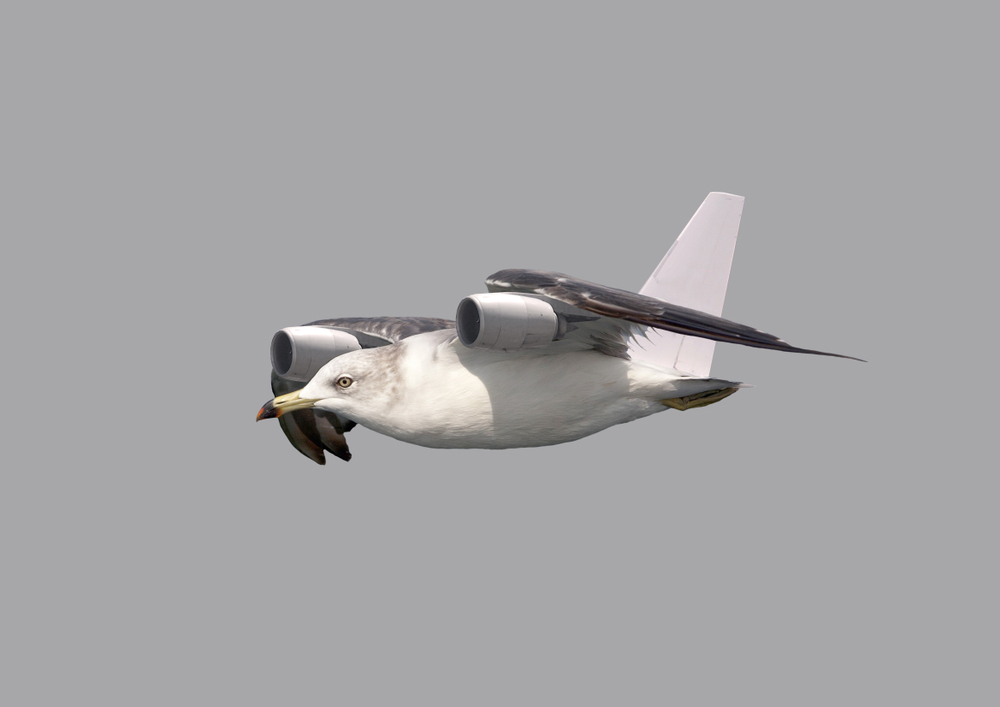Zombie Birds are Here and They May Be Spying on You

With all of the coverage they have been getting lately, you may think the only things in the sky these days are balloons. It turns out there are many other strange things flying over us … and some are spying on us just like those balloons. And like the balloons, these flying objects are being mistake for something else. No, not UFOs … birds. A paper presented recently at a scientific conference revealed that researchers are creating zombie birds – using dead ones and sophisticated flapping mechanisms – for the purpose of spying on the general, unsuspecting public. Have we already been fooled by them? Is this the real “Birds aren’t real” movement?

“It is very practical for research purposes and can keep nature undisturbed.”
“It” is a zombie bird created by Mostafa Hassanalian, an assistant professor of mechanical engineering at New Mexico Tech and the lead author of a paper, “Taxidermy Birds as Platform for Flapping Wing Drones: A Bioinspired Mechanism for Wildlife Monitoring,” presented at the recent American Institute of Aeronautics and Astronautics’ SciTech Forum. In his session, Hassanalian explained how he, Mohammad Moin Khan, Paige Gee and Jared Upshaw went looking for ways to make wildlife monitoring so natural that neither birds nor other animals nor humans could tell that what they were looking at – and what was looking at them – was not a bird but something else. Hassanalian knew the capabilities and restrictions of using conventional drones for wildlife observation, so he decided to develop drones that look exactly like birds. And what better platform to build a lifelike bird drone upon than an actual bird?
“This paper looks into the use of taxidermy birds on flapping wing drones so that wildlife monitoring will be more seamless and natural.”
Before you report his team and project to PETA or another animal protection organization, Hassanalian assures us that no live animals were killed or otherwise harmed in the making of these natural drones. The team used dead birds that were taxidermized – that is why these drones are zombie birds. For the demonstration, they used a dead pheasant and a dead pigeon … well, parts of them. One zombie was made with the pheasant’s head and body; the other used the pigeon’s wings on the body of a robotic bird. (Photos of the zombie birds can be seen here.)
“By using 3D flapping and aerodynamic simulators, limits of aerodynamic flapping characteristics could be set for the drone for a specific set of wings.”
As Dr. Frankenstein might say after reading the study, “It’s alive!” Well, it LOOKS alive. Videos (see one here) show that the zombie birds can glide, hover in place, fly, change altitudes and even maneuver into hot thermal currents so they can be carried up and along while conserving their batteries. Hassanalian admits that it is difficult to create a zombie bird drone that is indistinguishable in looks and especially behavior from a real one. But even the most cynical would agree that Hassanalian’s zombie birds aren’t that far off.
“Improvements on the flapping wing drone would be to make the overall drone look more natural. Spur gears can be changed to helical gears so there is reduced noise and an increase in longevity.”
The easiest changes would be to make the wing flapping more natural – a challenge that requires different flapping for different birds from eagles to hummingbirds. Improvements in gears and other mechanical parts would make the zombie birds sound less like drones and more like silent but deadly hawks and owls.
“Bendable wrists would help in making the wings more flexible in flight. Adding different flight options to the drone could yield an easier user experience and aid in a more natural flight.”
Improvements to the computer algorithms or AI controlling the zombie birds will help give them the many maneuvers real birds make. Hassanalian has done other studies of migrating birds to determine how to mimic the flying V formations that allow geese and duck to conserve energy. He has also studied feather colorings and patterns and how they affect heat absorption and airflow. Different zombies would then have different algorithms to match the bird they mimic – some would be long-distance gliders while others speedy dive bombers. However, the most difficult and challenging improvement is to make the zombie bird look natural when its batteries run out.
“A final improvement would be to add legs so that the drone can perch and monitor without using much battery.”
These improvements are all doable in the near future. Then what? While the noble causes of the study are “wildlife monitoring” and improvements in aerodynamics that could be used for commercial aircraft, the paper notes that future zombie birds could end up as “spy drones for military use” or weapons. In fact, Hassanalian has already been cooperating with the FBI in its efforts to combat weaponized drones. It is a challenge similar to making zombie drones. Those must look and act like real birds in order to hide. With businesses using drones for deliveries, Hassanalian says those making weaponized or spy drones will need to match the delivery counterparts.
“You can get those drones from the market right and you just need the explosive material. This is also a future concern of the concept of advanced air mobility, which for example, we now see that Amazon wants to use drones for delivery. We want to integrate drones into our cities for multiple applications that they will have, so here cybersecurity is another aspect of this.”

Could the zombie bird drones be used to fight the weaponized and spy drones?
“I believe that this is a threat, and I think there needs for more research to design some anti-predator, anti-drone systems.”
The “Birds Aren’t Real” movement was a hoax based on the conspiracy theory that birds are not living creatures but are actually drone replicas created by the U.S. government to spy on Americans. While we know that birds are real, we now know that zombie birds are also real and can be used to spy on Americans.
There was a time when we warned others to “Be careful what you wish for.” Perhaps that needs to be updated to “Be careful what you meme for.”




